 TigerSoft New Service 7/23/2010
TigerSoft New Service 7/23/2010
Make
Money. Use TigerSoft To Track Key Insider Buying and Selling in All Your Stocks
www.tigersoft.com PO Box 9491 - San Diego, CA 92169 - 858-273-5900 -
william_schmidt @hotmail.com
-------------------------------------------------------------------------------------------------------------------------------------------------------------------------------------------
Street Professionals Now Rig Stock Prices
with
Extra FED Help and Approval
WALL
STREETOCRACY
How They Do This. How We Tiger Users Can
Profit
by William Schmidt, Ph.D. (Columbia University)
C) 2010 All Rights Reserved.
Market Professionals Now Rig Stock Prices
with Extra FED Help and Approval
by William Schmidt, Ph.D. (Columbia University)
C) 2010 All Rights Reserved.
Read also my:
April 9, 2010 The Power Elite's
Biggest Gamble of All. They Cannot Afford to Lose.
That's Why The
Market Looks Like It Will Keep Rallying.
April 4, 2010 Why The Stock Market
Keeps Rallying:
The Secret Deal
Obama, The Fed and Wall Street Have Reached.
April 9, 2009 Goldman Sachs Is "The GREED CONNECTION"
between Wall Street and
Washington
April 25, 2009
Massive Federal
Reserve Fraud and Corruption Story Breaking..
Bernanke Covers
Up Hundreds of Billions of Dollars in Losses
from Bad Loans
The Fed Made To Banks Using Toxic Collateral.
WALL STREETOCRACY
My main thesis since March 2009 has
been that Obama, rhetoric aside,
has done the bidding of Wall Street.
March 23, 2009 Monopoly Finance
Obama Obama's Biggest Wall Street Contributors Fleeced
Shareholders on
The Way Down And Now Will Fleece Taxpayers on The Way Up.
March 25, 2009
Why Is The Stock
Market Rallying? Wall Street Now Sees That Obama's
Populist
Rhetoric Is Designed To Fool The Angry Public Obama Is Signaling Wall Street
He Will Protect
Them
Obama and the FED have given Wall Street nearly
everything it wanted
and wants. In return, Wall Street has
agreed to use its powerful program
trading tools to pump the market up and limit
short selling. The low trading
volume and very good breadth shows this.
Program trading by
firms like Goldman, JPMorgan and Bank of
America (through Merrill
Lynch) push prices up and up. Volume
remains low because the public is
absolutely traumatized, mistrustful and
dangerously pauperized.
Nor are Institutions are big buyers. They
doubt the rally, because
of how far the advance has outpaced the
economy, especially in
the area of job creation. What institutional skeptics fail to appreciate
is the power of program traders now.
These Wall Street go-go types
are safely backstopped AND bankrolled by the
U.S. FED and there
is no challenge from any significant political
force is being made to
this FED policy under Bernanke.
Obama has
recklessly and cynically gambled that a rising stock
market will eventually inflate the wealthy's bank
accounts so much
that they will start spending their profits and that
will boost business
and job creation. Meanwhile millions wait and
wait for a job that
never appears. How long must thet wait for
Obama's trickle-down
gamble to pay off.
Eventually there
will be more jobs. Even old cars and dish washers
need replacement. But without jobs, people are
poor consumers for
a long time to come. Only marginal gains are
coming. I suspect
more jobs are going overseas than are now being
created. One of
the hot areas now to invest in are the companies
specializing in
outsourcing.
October 15, 2009
Unemployment Statistics: The Real
Story.
Obama's Shame Is His Total
Subservience to Wall Street.
Today, July 23,
2010, the Administration said that they do not
expect unemployment to drop below 9% for two
more years.
Why should the unemployed continued to show
patience? Obama
and the Democrats are seen as failing them.
Meanwhile Wall Street
is happy. Big banks that are "too big
to fail" are not "too big"
for this Administration or Democratic
Congress. Easy Fed money
without strings is reely available
in exchange for toxic debt
collateral. Commercial Banks can be
stock brokers and vice verse.
Goldman has gotten away with
massive fraud for a slap on the
wrist. And today, the Obama
Administration announced it was OK for
publicly subsidized
banks to pay their chief executives $1,5
million a year.
Obama is clearly a Wall
Street puppet. He has no backbone or
experience. He depends on ex NY FED
Geithner and Larry Summers,
long a friend of Wall Street.
Larry
Summers, Tim Geithner and Wall Street's ownership of Obama
The
Corruption of Larry Summers
Larry
Summers Defends Megabanks
Hedge
Fund Paid Summers $5.2 Million in Past Year - WSJ.com
Is
Larry Summers Taking Kickbacks From the Banks He's Bailing Out
With the help of these
Wall Street promoters, Obama is gambling
big time that a rising stock market will lift
the economy and create
millions of Amercian jobs. With so little
job improvement taking
place, the disconnect between Wall Street amd
Main Street gets
bigger and bigger. Obama has forgotten the words "public works".
Now he takes up the bankers hyocritical call
for balancing the budget.
The danger of another bubble and then a market
collapse grows.
That is the reason we now see a massive head
and shoulders pattern
in the major market indexes.
Tiger Hotline used are
watching the market closely now. We have
learned to trust the automatic Peerless and
TigerSoft's Buys and
Sells AND watch especially Tiger's Closing-Pro Power
Indicator's
trends. As long as Closing Power keeps rising
we know the
Wall Street Program Traders are still net buyers.
Professionals are
still pumping the rally from the recent lowsm knowing
that the bears
will be in for a bad surprise if the head and
shoulders pattern fails.
Our nightly Hotline has discussed this possibility
and pointed out
the cases in July 1951, July 1983 and July 2009 when
similar head
and shoulder patterns failed.
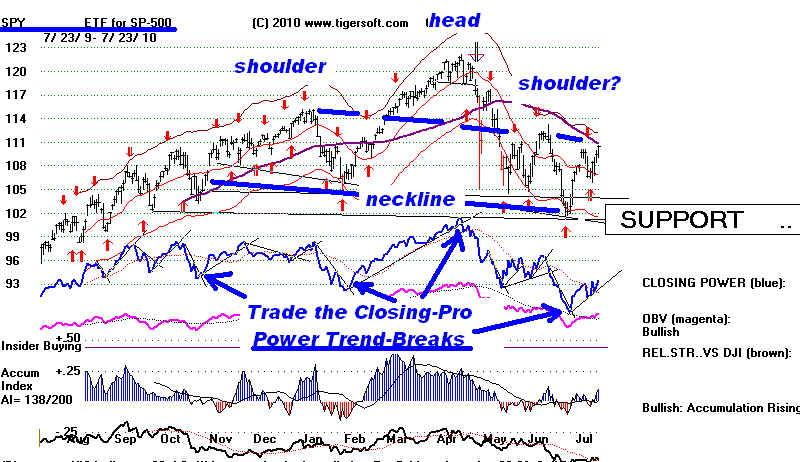
More TigerSoft
reading:
"How can I tell whether professionals are buying or
selling now?
I
want to trade in the direction that they are pushing prices, i.e. rigging the
market? "
Watch
the Trend of Tiger's Professional Buying Power Line.
When
to Sell a Stock
A
LITTLE HISTORY
The
Federal Reserve has always helped the big banks. Their
creation in 1914 came about, it was said
at the time, because the
Government wanted to prevent another
1907-like financial panic.
Severe economic slow-downs also followed
the bankers'' panics
and financial collapses of 1873, 1893 and
1896. Bankers wanted
a back-stop and a sugar daddy. They
wanted access to emergency
funds courtesy of the US taxpayer.
The theory of how monetary policy
could by incremental tinkering smooth the
business and investing
cycle conveniently became the mantra of
the new Federal Reserve.
All along, the Fed's real purpose has
been to bail big banks out
in an emergency.
At Best, The Powerful Fed Is A Work in Progress
with Its Own Budger and Very Little Accountability
Most often the Fed's economic far-sightedness Is as limited
as its Transparency.
The 1929-1933 financial collapse and Depression showed
that the Fed could be too stingy
and totally visionless, as it
accepted the reigning laissez-faire
philosophy of political economy.
The 2005-2010 housing and financial
bubble and collapse showed
that the Fed can also be too
generous, and equally visionless,
yet totally under the sway of the
mightiest big banks.
These failures of mission should put more political heat on
the Fed, one would think, bringing
new demands for more
Fed transparency and public
accountability. Not surprising given
the size of Wall Street's campaign
contributions to Congress
and Presidents and how extensively
Goldman Sachs personnel
now run many government
departments, the move in Congress
to control and reform the Fed is
heard only from a handful of
Progressive Democrats and the most
doctrinaire laissez-faire
Republicans.
That the Fed has only achieved a jobless stock
market rally should bring more
public outcry and outrage in
Congress. But it has not.
The Democrats, by in large, are just
as bought and paid for by Wall
Street as the Republicans are
dominated by big business.
IT IS HARD TO
OVERSTATE THE POWER OF WALL STREET
JP Morgan Issued The President An Ultimatum in 1907
In 1907, many big over-leveraged banks
failed or teetered on failure,
just as in 2008. In 1907, there
were runs on banks. There were no
government guarantees of depositors.
Liquidity dried up almost
completely as stocks lost nearly 50%.
The "bankers' panic" (as it
was called then) quickly killed business
confidence and brought
a broader economic recession and a steep
rise in unemployment.
This greatly reduced consumer buying
power making. There was
no Keynesian concept then of the positive
role of Public Works spending.
So, the economy spiraled downwards.
If the End of the Gilded Age in 1907 sounds exactly like what
happened
in 1929-1938 and 2008-2010, it is
because it was the same. Someone
needs to talk about how a very
narrow distribution of wealth inevitably
leads to an economic collapse when
stock prices fall in a financial panic.
There is just not enough buying power and
consumption depending on
the very wealth. This is sad
because there are always more than enough
public works' tasks that are needed.
Defenders of the big banks often assert
that the 1907 panic ended
because of the heroic efforts of
financial mogul J.P.Morgan to round
up massive financial guarantees for
failing banks and brokerages
at meetings he organized with other big
bankers and brokerages.
He certainly filled a vacuum of
leadership. Cynics can say he was just
protecting his fortune, but he also acted
out of a sense of noblesse
oblige that today's CEO's certainly do
not feel or show.
There is more to the 1907 story.
Just as Henry Paulson put a gun to
Congress in September 2008, so too, did
JP Morgan and his circle
of big bankers, do the same to President
Theodore Roosevelt.
HOLDING
THE ECONOMY HOSTAGE
Two hours before the Opening of
stock trading in NY, on a
still dark November Monday morning
in 1909, a new Market
Crash seemed imminent due to
imminent new larger bank failures.
The day before IP Morgan had sent
emissaries from US Steel (which
he owned) to meet Roosevelt in
Washington. US Steel's Elbert
Gary
and Henry Clay Frick informed the
President had to relax the ban
on steel company mergers under the
Clayton Anti-Trust Act and
allow the JP Morgan empire to get
still bigger, or there would
most certainly be a dire financial
collapse.
"Roosevelt relented, and he later recalled of the meeting,
"It was necessary for me to
decide on the instant before the
Stock Exchange opened, for
the situation in New York was such
that any hour might be
vital." News of
Roosevelt's concession
sent the market soaring that
Monday and the panic ended.
(See - http://en.wikipedia.org/wiki/Panic_of_1907
)
The
next year Congress created a National Monetary Commission to
investigate the causes of the panic
and make recommendations
to regulate banks. Republican
Rhode Island Senator Nelson Aldrich
spent two years in Europe where
countries did have central banks.
When he returned the nation's most
powerful bankers met secretly
in November 1910 for a week off the
coast of Georgia and crafted
Aldrich's "Currency
Report" which became the basic of the Federal
Reserve Act of 1913.
WHAT'S NEW NOW?
Ever since 1913, the Federal Reserve has had the power to create
money, by virtue of making massive
and cheap loans to banks that
belong to the Federal Reserve
system. Though the President nominates
the Chairman, it is the member
banks that pick the regional Federal
Governors that run the Federal
Reserve. For all practical
purposes,
the Federal Reserve answers to its
member banks far more than it
does to the President or Congress. Hence, Bernanke's refusal to
supply the details of his trillions
of dollars in loans to the biggest
banks.
#1 What's new first is that now the nations biggest
banks are again
allowed to be stock brokers. In 1934, that had been disallowed because
too many banks had failed as a
result of playing the collapsing
stock market with leveraged cheap
money they got from the
Federal Reserve. This law was
the Glass Stegall Act of 1933,
which also set up the Federal
Deposit Insurance Agency to insure
bank deposits, In November 1999, Congress repealed this prohibition
on banks owning brokerages and
investment banks. Politicians
were "snowed" by Fed
Chairman Greenspan and how much the
deregulation he advocated had
apparently sent the stock market
soaring. Few seems to have paused
long enough to realize that
the boom was the result not of
Deregulation as much as it was the
technological transformation caused
by the personal computer
and the internet.
There were a few exceptions. With remarkable prescience,
Senator Bryan Dorgan of North
Dakota in 1999 warned that the
repeal of Glass Stegall would cause
another financial collapse
and massive taxpayer bailout of
banks.
There can be little doubt that the removal of the divide between
Wall Street brokerages and
investment banks on the one hand
and depository commercial
banks led to the collapse of the sub-
prime mortgage market, the
Financial Collapse of 2007-2010
and the bankers' secret
trillion dollar bailout by the Federal
Reserve.
Brokerage-Banks, with all their muscle got the Fed to
relax regulations on housing
loans.
#2 What's new. secondly, is that the current Fed Chairman, Bernanke
has loaned Trillions of
Dollars to the biggest retail banks,
which are now also brokerages
and investment banks. He is not
known as Hellicopter Ben, for
nothing. As an academician, he s
studied the Fed policies in
the 1930s and concluded that the
Fed was then far too tight.
He has gone to the opposite extreme.
He made these loans without
demanding any guarantees that
the banks use the credit to
make more business or consumer loans.
What is worse, he has lent
trillions to the banks in return for the
collateral of their toxic bad
mortgage and consumer loans. All
of this has been done by the
Fed with as much secrecy as possible.
#3 The Banks are Using much of this money to play the stock
market and buy US Treasuries.
There is no prohibition now
against this.
Naturally, the stock market has zoomed upwards.
Obama's Treasury Secretary
Geitner and Chief Economic
Advisor Summers both are
closely associated with banks and
have been proponents of
deregulation. So, rather unbelievably
for a Democratic
Administration, there is Executive branch
pressure on the Federal
Reserve to require banks use the
money they get from the Fed
to make consumer and business
loans. Not
surprisingly, the stock market has gotten far ahead
of the jobless recovery,
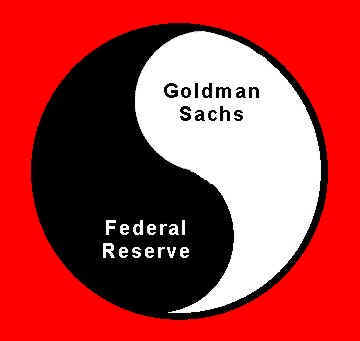
( http://seeker401.files.wordpress.com/2009/07/goldman.jpg
)
#4 While
Geithner was the NY Fed Governor, the biggest and
most aggressive investment
bank, Goldman Sachs, was made
an honorary commercial bank,
thereby giving it unlimited access
to the Federal Reserve's
Discount Window, So, even though no
one has ever had a Goldman
Sachs Master Card, it can borrow
very extensively and secretly
from the Fed at interest rates that
are close to 0. For all
practical purposes, it has access to as
much money as it wants behind
it.
#5 Using its money to bribe Congress and the
Administration,
its massive computerized
program trading is wholly unregulated
and now undisclosed. Goldman, JP Morgan and Merrill can
run the market up as much as
they want. Their stock market
trading programs have more
impact on share prices than most
financial news. As the
biggest program trader, Goldman has
become a trading terrorist.
It can hold the market up as hostage.
When it gets caught with its
hands in the cookie jar, as when
it simultaneously shorted
mortgage bundles it was selling clients,
there are no criminal charges
and it gets its fine reduced to
not even two days' trading
gains.
So, I contend, Goldman and its big bank brethren can collude
and rig the market anyway
they want to, although one has to
believe the Administration
would privately create a fuss with
them if they did too much
short selling.
WHAT PROOF HAVE WE ABOUT SO
MUCH RIGGED TRADING?
I have written about this before:
http://www.tigersoftware.com/TigerBlogs/May-7-2010/index.html
See also U.S. Fed Rigs Stock
Market - January 11, 2010
Until July 2009, the NYSE published detailed program trading records.
From this, we can see that
"program trading
averages more than 50%
of all of the trading
done on the stock market". Among the secret
group of powerful program
traders, Goldman is the biggest by far.
It dominates the computerized
quick program trading, trading for
its own account 95% of the
time. It can put in and pull out hundreds
of millions of Dollars in the
market in minutes on a thousand stocks
at a time.
http://www.nytimes.com/2009/07/24/business/24trading.html?adxnnl=1&adxnnlx=1279926107-FFGk/KS7zyP/sXOJXv4SFQ
http://zerohedge.blogspot.com/2009/05/observations-on-nyse-program-trading.html
http://zerohedge.blogspot.com/2009/07/themis-trading-principal-program.html
May 6th - 7% Intra-Day Decline in DJIA
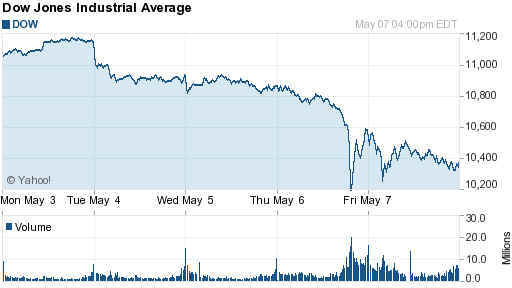
THE DANGERS OF SO MUCH RIGGED TRADING
Severe declines of 5%
or even 10% and possibly more in a few
minutes or hours
WITHOUT ANY ECONOMIC JUSTIFICATION
are becoming more
frequent. 1987, 2008 and 2010 show this
dramatically.
From my Blog of
http://www.tigersoftware.com/TigerBlogs/May-7-2010/index.html
I quote
Look What Computerized Trading Did in 1987.
Are We Doomed To Repeat 1987?
Where Are The Regulators?
Must They Always Be The
Puppets of Wall Street.
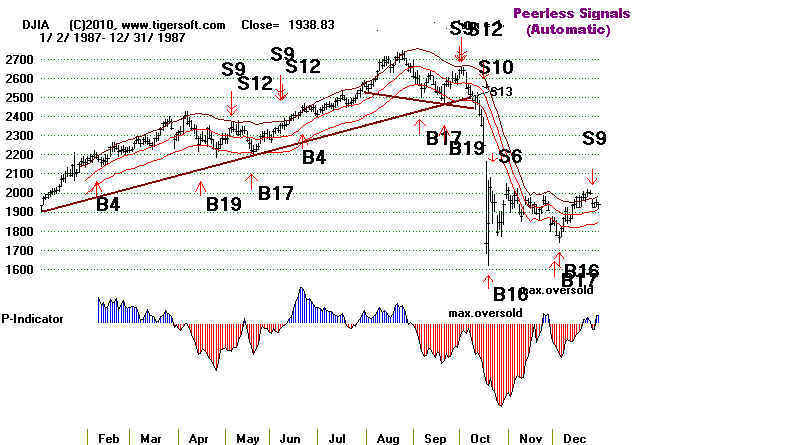
What Goldman's Program Trading Gave Us
in 2009, It Could Take away in 2010
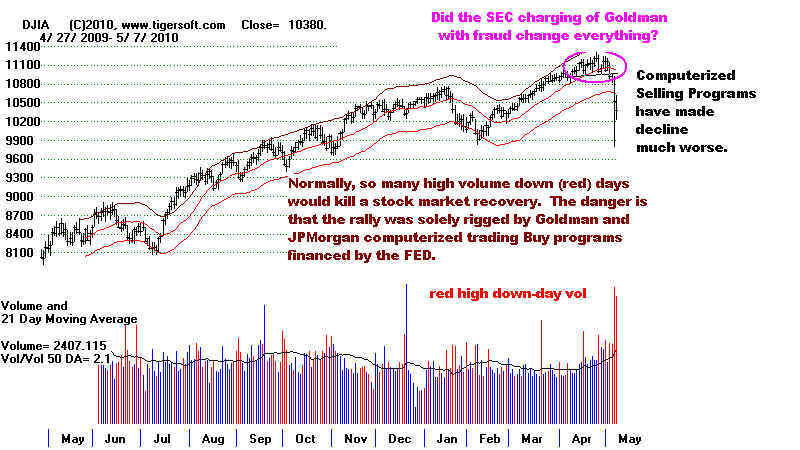
Is Goldman Sachs Playing "Hardball" with
The Administration?
The market
started down immediately after the SEC announced it was going after
Goldman Sachs for fraud. It is quite possible that
Goldman wishes to show Obama, the Treasury
and the SEC who is really boss. The Fed already
knows. That's is why it has given trillions
My view has been
that Goldman Sachs has been a key member of the Power Elite that
has been boosting
the market since March 2009. The Fed has been providing the money. Goldman
and JP Morgan have been program-trading stocks
upwards. And the Obama Administration
has been laying off the populist rhetoric and
slipping Wall Street favors under the table.
But now that alliance seems to be breaking up.
Obama's Attorney General has let it slip
that criminal fraud charges will be brought against
Goldman. That could spell big trouble for
the stock market if it's true that the gains for the
last year have been mostly artificial, i.e. they
do not reflect an improving economic outlook. If
Goldman starts using Sell Short programs
as effectively as it has its Buy programs, much of
the last year's market gains are in
jeopardy. But would Goldman really want now to
declare war on the US Governmnet like
it has Greece? That would make the Government
go after it with total vigor and resolve.
More likely, the government will let Goldman off the
hook for what seems like a big fine,
perhaps $100 million, and things will return to
"normal". In return, Goldman will not use its
computerized sell programs and, in return, continue
to get the full support of the Federal Reserve
and not be prosecuted criminally.
In the last few years, high-frequency
100% automated trading has come to dominate ALL
NYSE and NASDAQ trading. This trading is conducted by
Goldman Sachs, Barclay’s Capital,
Wedbush Morgan, Credit Suisse, Deutsche Bank, JPMorgan and
RBC Capital (Royal Bank of
Canada). Goldman is the most active in using this
type of trading for its own account. Such
trading is very lucrative. Look at Goldman's
earnings, $9 Billion in the lat two quarters along.
Automatic computerized
trading now accounts for 20%
to 75% of any given day's trading.
Barrons's provides the
data on the weekly
NYSE buy, sell and arbitrage trading each week
as a percentage of NYSE
volume.
Last July, as the market was leaping upwards, computerized
trading amounted to 75% of all NASDAQ trading, of which
Goldman accounted for 90%. Last
July, I wrote: "Goldman now trades
much more aggressively for its own account, as principals,
far more than any
other brokerage or investment bank. The current ratio of trading for
themselves as
opposed for clients is 5:1, among the very highest on Wall Street."
Last year
the code for Goldman's computerized trading was
stolen by a Russian who had worked
for them.
Imagine what might have happened if this Russuan programmer had sold
the code to some country that wanted to destroy America.
Wall Street tell us that their
trading provides liquidity and depth to the market. Thursday's
volatility shows how fraudulent such a defense is.
Clearly rhere is real danger in their uncontrolled
high frequency computerized trading. on Thursday, the
DJIA fell 700 points in 10 minutes! At
that point it was down almost 1000 points intra-day,
9.997%, from the previous day's close. A week
of this type of action will wipe all the gains of the last
year.
Last week's computerized trading
and downside volatility are very worrisome. Does
Goldman think the US market is on very weak underpinnings?
If they can send it up, then
why can't they send it down the same way? And who will want
to buy in a market with
so much volatility. Thursday's decline was not due just to
a "trading glitch". If it had been,
the market would have risen Friday. Instead it fell
another 140.
Besides their magnitude, speed and
ubiquity, the central trading issue here is that these high
frequency computerized buy and sell programs are often
"pile-on programs". The computers don't
care what caused the initial move in the first place.
It could be a news event or it could be an
error in an order hand-entered, which says sell billions
instead of millions of dollars of stocks.
The computers don't care. They just trade and
reinforce the trend. The danger here, of course,
is that they usually exaggerate market moves, very
dangerously and totally recklessly. And
in the process, they quickly destroy investor confidence.
That affects retirement accounts,
business confidence and thus jobs for working people on
Main Street.
Where are the regulators? No
where! For years and years, the regulators have just done
whatever the biggest Wall Street firms want, as when
Goldman saw a bear market coming in mid
2007 and prevailed upon Securities Exchange Commisoner Cox
to allow short sales on downticks
for the first time since the Depression. In June
2007, the SEC bowed to pressure from Goldman
Sachs and suddenly allowed short selling on down-ticks and
stopped policing the requirement that
shares first be borrowed before they were sold short.
From 1934 to 2007, selling short on
down-ticks and naked short selling had been banned because
of how pernicious rigged selling by
bear raiders had been between 1929 and 1933. In
the New Deal era is was appreciated that
Wall Street could not be allowed to run wild.
Businesses would be bankrupted if big organized
Wall Street bear raiders were free to create panic and
ruin.
The computer programs often buy and sell
automatically when prices rise or fall a certain amount
or trade past a certain price level. trading firms
have computers that are programmed to automatically place
buy or sell orders based on a variety of things that happen
in the markets. Clearly, allowing this
relatively new type of computerized trading gives the
fastest firrms an advantatge. But that removes
human conrols. And the end result is a sharp increase
in downside volatility when days are already
down a lot. We should have learned the dangers of
allowing this trading from the October 1987
experience, but de-regulation and the domination of
"regulators" by the biggest Wall Street firms
have made matters much worse.
Some circuit breakers do
exist. These were instituted after the 1987 crash, but they were very weak,
did nothing to limit the growth of computerized trading and
, worked only for a limited amount of time during
the day and only went into force when the DJI was down more
than 10%. Worse, there is no halt in trading
in the last hour and a half unless the market is down 20%.
The regulators have clearly failed
the small invetsor again. In one egregious case on
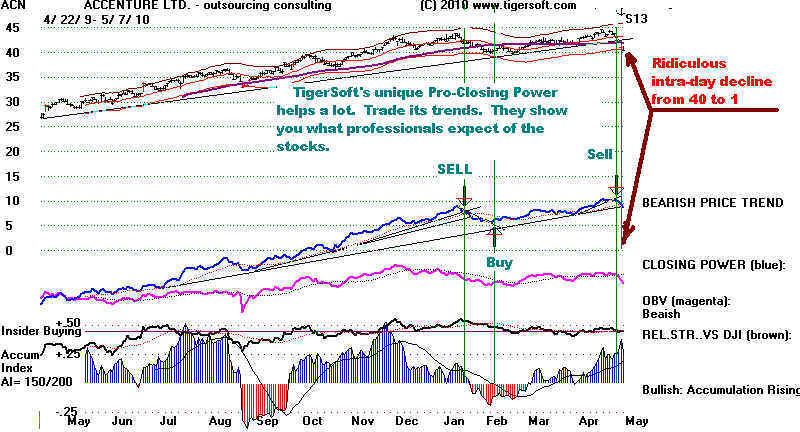
More
Information
http://home.comcast.net/~royashworth/Mutual_Fund_Cash_Levels/Mutual_Fund_Cash_Levels.htm
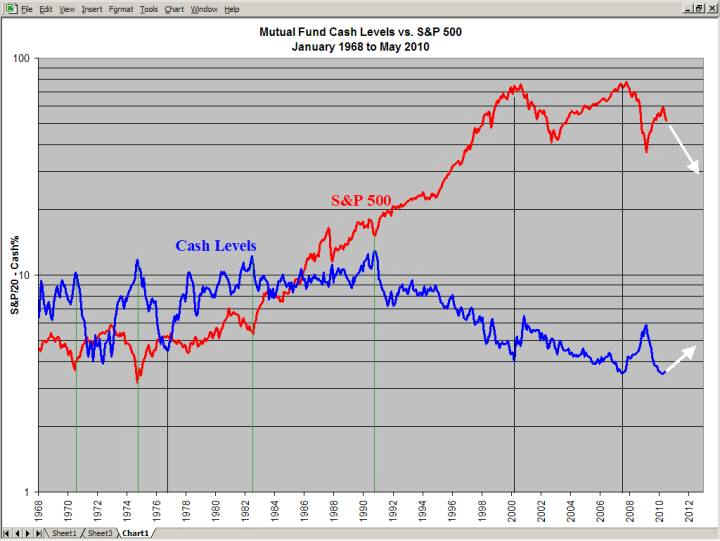
1) Major
rallies occurred in 1974, 1982, and 1990 when the cash levels were greater than
11%.
2) The
market sold off in 1973, 1976, and 2000
when cash levels were below 4.5%.
3) The
old historical low was 3.9% in 05/1972. The market top was 12/1972 followed by a 46%
decline. The next historical low was 4.0% on 03/2000 followed by a 43% decline. New
historic lows of 3.5% were set in June and July 2007.
4) Cash
levels reached 6.5% in November 2000 but the market declined to a bottom in October 2002.
5) Cash
levels reached 5.9% in February 2009 then rolled over sharply.
6) The
May 2010 level was 3.6% compared to 3.5% in April and 4.8% in May 2009. Cash levels are at
a historical low. The last historic low of 3.5% was set in June and July 2007. The S&P
top occurred several months later in October 2007. This suggests the next top around
July-August 2010.The next decline should be similar to 2000-2002 and 2007-2009 (50-60%).
7) Cash
levels will have to move much higher before the secular bear market ends.
Stock funds posted an outflow of $24.67
billion in May, compared with an inflow of $13.24 billion in April. Among
stock funds, world equity funds (U.S. funds that invest primarily overseas) posted an
outflow of $5.75 billion in May, vs. an inflow of $8.21 billion in April.
Funds that invest primarily in the U.S. had an outflow of $18.92 billion in
May, vs. an inflow of $5.03 billion in April.
 TigerSoft New Service 7/23/2010
TigerSoft New Service 7/23/2010 






